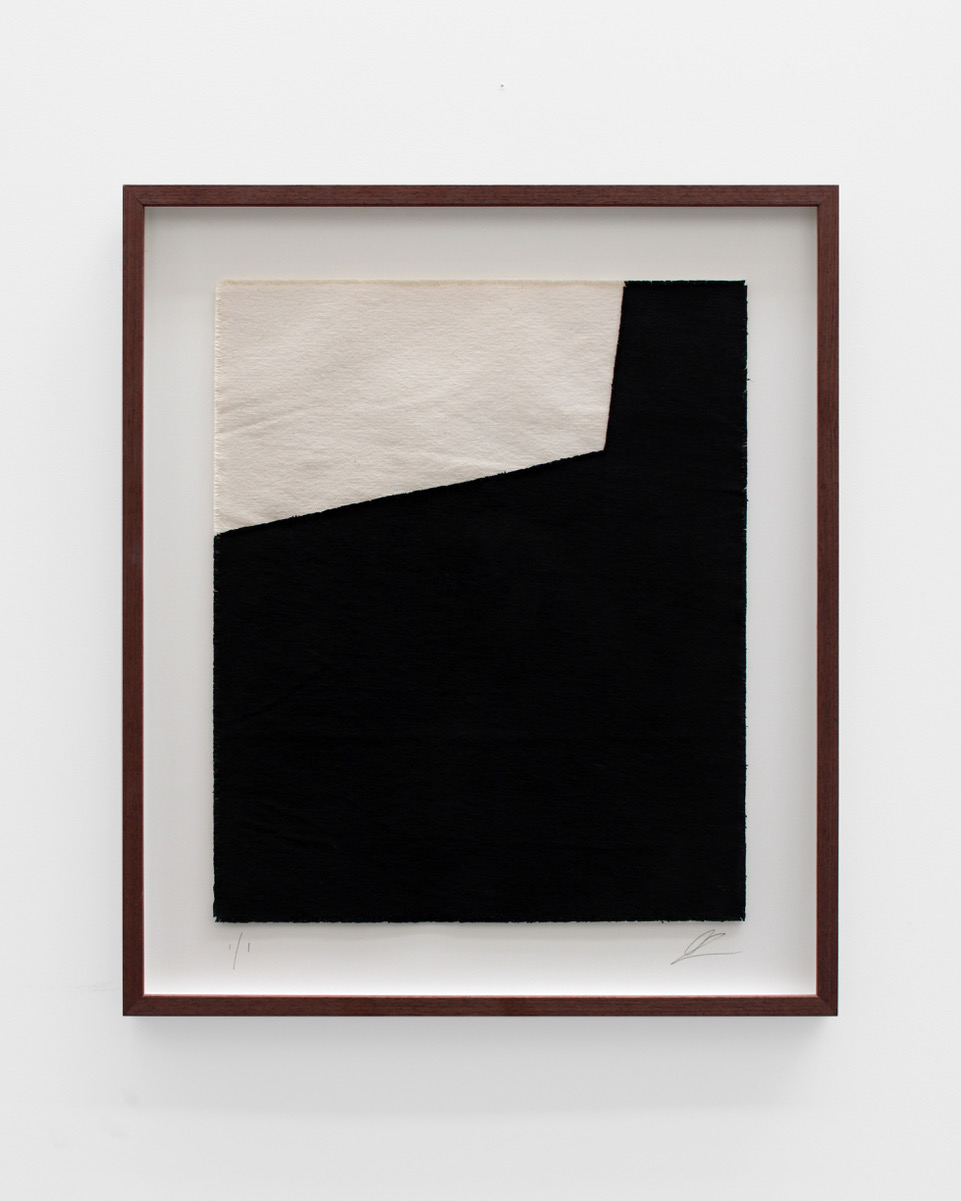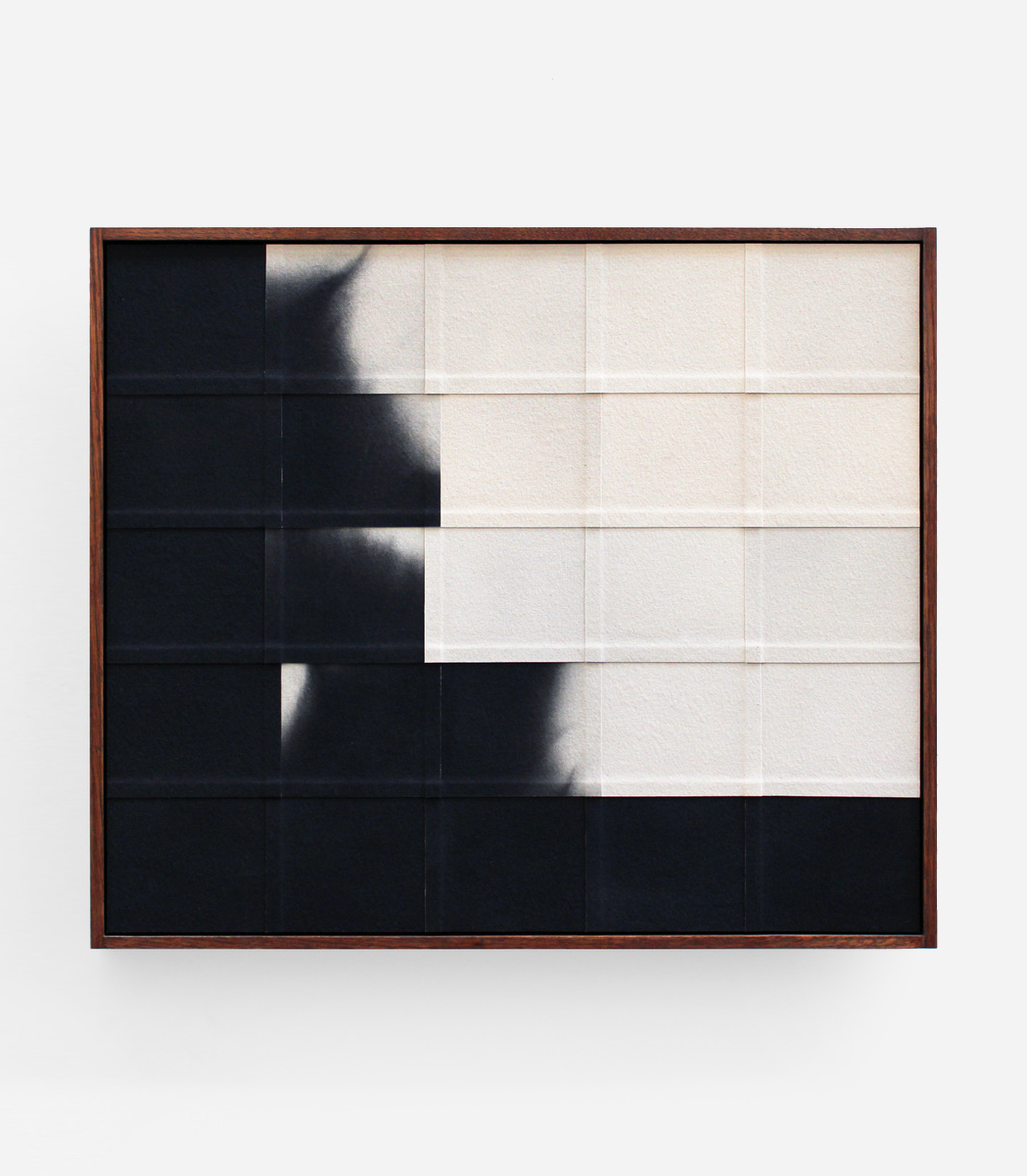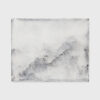“3 Questions for…” showcases and promotes the work of upcoming artists in the early stages of their careers. This time I would like to share with you the monochrome works of Woolway.
British artist Henry Woolway (b. 1987) creates minimalist artworks that reflect his personal relationship with past and present life experiences. Originally coming from television and film design, Woolway developed his distinctive artistic language during the first lockdown in 2020.
His monochrome works, inspired by Scandinavian and European design and mid-century modern influences, emerge from a labor-intensive process: The artist repeatedly applies diluted black acrylic paint to the wet canvas so that it penetrates the surface while the texture of the canvas remains visible. He then applies white paint to the back of the canvas to stiffen the canvas and varnishes the front. Once dry, he cuts the canvas into panels, which he reassembles in a different layout.
For Woolway, this process mirrors the stages of memory being formed – the initial painting represents the moment experienced, the cutting symbolizes the passage of time, and the reassembling reflects how memories are recalled, sometimes altered or fragmented by time and perspective. These monochrome, understated works radiate both calm and dynamism, inviting viewers to engage intensively with the work, thus creating space for personal reflection. To learn more about his process and his work, I asked him three questions:
Henry, what inspired you to become an artist, and how has your artistic expression evolved since then?
I never went to art school and I didn’t enjoy art at school as it was so prescribed, you always had to build up to a final art piece to show how you got there rather than just being creative and seeing where you got to. I was always creative and loved drawing for drawing’s sake. It wasn’t until my late 20’s that I felt confident enough to get a studio space without it feeling like a waste of time or not something I should be doing.
It took years to get to my style I’m working on now, and as soon as I found that style, I knew I’d found my true art self. I never set out to be a selling artist. I just wanted to show my work, and during the first lockdown in 2020, Instagram was the place to do it. My following increased, and during that first lockdown, using the hashtag #artistsupportpledge, I started selling 4 paintings a week, and it helped me get through the lockdown financially.
After that I was lucky enough to pick up a few galleries and get into some art auctions. So it all happened very quickly at the beginning and then carried on after organically. If I never sold another painting, I would still spend hours in my studio creating.
How would you describe your work to someone who has never seen it, and what do you hope viewers take away from it?
My work is based on monochromism and texture. I only use black paint on raw, extra-fine canvas. The black is soaked into the canvas with a feathered edge to the raw canvas. The panels which make up the final piece add abstraction to the initial painting by placing them back in a different pattern, and the overlapping of the panels adds further texture and depth and makes small shadows in the work which move as natural light hits it through the day.
I focus on lighter paintings with the black being the negative space or vice-versa. The warmth of the oak frames completes the paintings and hopefully gives them a timeless feeling, leaving the viewer wondering if they’re modern, contemporary, or something from the middle of last century.
What are you currently working on and what are your plans for the future? Are there any subjects that you would like to explore further?
I have jumped around a little more than I am now in the past. I’m currently working on making small changes in each new work and allowing the changes to be almost unperceivable. I am currently enjoying settling into the current process and ethos. The paintings change a lot just by the placement of the panels once cut.
I would like to bring more confidence to them by minimising the painting process while still remaining enough for the viewer to keep enjoying and noticing new shapes, patterns, and interests. I am planning to work in scale both in singular paintings and also in a collection, I’d love to do 30 or 40 paintings all at a decent size but shown together on a large wall, which makes up a whole painting.
It took years to get to my style I’m working on now, and as soon as I found that style, I knew I’d found my true art self.






